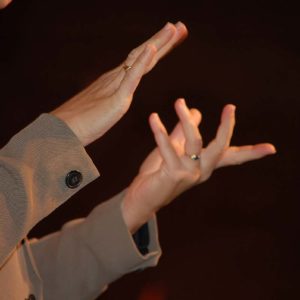Babies can quickly learn how to sign. Both their understanding of language and their motor skills develop much faster than their ability to speak and they love to mimic. Most babies, for example, discover how to wave and point long before they can say, ‘bye-bye’ or ‘look at that’
Sign language aids speech development and according to experts, most baby signers speak earlier than babies who do not learn sign language.
Why should I use sign language with my baby?
The simplest answer is that using signs allows your baby to express with gestures before he or she is able to speak with words. Many people teach their hearing children a little bit of sign l before they can even talk. It can help little ones to learn how to effectively express their needs better before their verbal communication develops. ASL is a visual language and it often uses variations of signs to create visual stories. The process of making these stories involves critical thinking that could be applied to storytelling and creating messages in other languages.
7 Benefits of Learning Sign Language for Toddlers
When you give babies specific tools to use for communication, it helps them to explore language and understand how it works. Here’s a snapshot of the many important benefits of baby sign language:
- Gives a pre-verbal child a way to communicate
- Aids the child’s understanding of language
- Increases communication opportunities
- Decreases a child’s frustration
- Decreases caregivers frustration and confusion
- Strengthens the social & emotional bond
- Helps the child learn that movements have meaning
Is my toddler too old for baby sign language?
Simply, no.
Sign language can be a valuable tool for toddlers even once they can talk because it can be really hard for them to access and use the spoken words they know when flooded by big emotions (frustration, anger, etc.).
Baby signing experts believe that frustration and tantrums can be avoided by closing the gap between the desire to communicate and the ability to do so. Infants who learn baby sign language also are thought to gain psychological benefits, such as improved confidence and self-esteem.
Over 30 years of research has shown that nonverbal people with autism can learn to communicate with sign language. Many autistic children respond well to sign language because it’s visually based and provides a mode of quick communication. Research also shows that it may actually help nonverbal people to become verbal.
Frequently Asked Questions
1. Should babies need to be taught sign language?
Baby motions and gestures can be effective for parents and guardians who want to encourage their children’s formative communication skills. You may utilize sign language to teach the baby how to express desires and needs to you. Young kids could be trained to communicate more effectively with infant signs and actions.
2. When is the best time to introduce baby sign language to your kid?
Once your child is around six months old, begin signing. Studies show that babies reach a developmental stage for gestures between 6-12 months (typically nine months). It is just the time when a baby sign language course online would be valuable for you.
3. Are baby sign language and ASL similar?
Not usually. Baby sign language pertains to utilizing signs and gestures to converse with a baby, whereas ASL is a comprehensive language with its sophisticated structure of syntax and word order rules.




